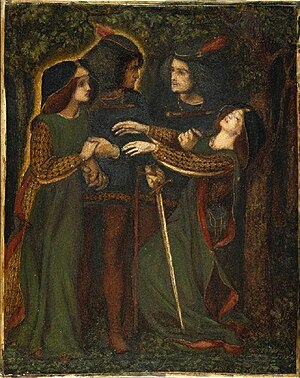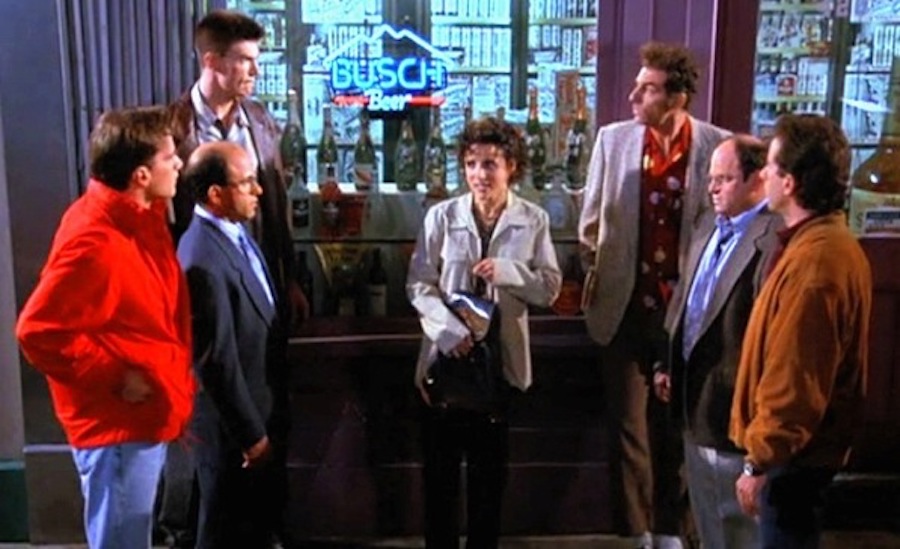
(…which could have resulted in a “lazy eye” like character actor Jack Elam – but didn’t.)
* * * *
 Here’s a break from Politics: Six years ago I was helping my brother take up the deck in his back yard. I ended up having a large nail – like the one shown at right* – shoot up and puncture my right eye.
Here’s a break from Politics: Six years ago I was helping my brother take up the deck in his back yard. I ended up having a large nail – like the one shown at right* – shoot up and puncture my right eye.
Since then I’ve learned to manage with one good eye. Then last Friday, February 24, I went to a local eye institute. I figured on getting my right eye fixed, but it turned out more complicated than I thought. (“Of which more anon.”) Which leads to one point of this story: That fooling around with sharp objects can indeed “put your eye out.” That’s what happened to veteran character actor Jack Elam, shown in the top picture.
Born in 1920, by the early 1930s he was living with his father and stepmother. (His birth mother died in 1922.) There – in south central Arizona – he “lost the sight in his left eye during a boyhood accident when he was stabbed with a pencil at a Boy Scout meeting.”
Then of course there was that famous exchange in the 1983 film A Christmas Story:
Ralphie: I want an official Red Ryder, carbine action, two-hundred shot range model air rifle!
Mrs. Parker: No, you’ll shoot your eye out.
 Which is pretty much what nearly happened.* Which leads to another valid point: That sometimes those old wives’ tales turn out to be true. (See also Old wives’ tale – Wikipedia.*)
Which is pretty much what nearly happened.* Which leads to another valid point: That sometimes those old wives’ tales turn out to be true. (See also Old wives’ tale – Wikipedia.*)
But getting back to the nail in my right eye: The thing I remember most about the incident – six years ago – was a feeling of utter stupidity. How could I have done such a thing? How could I have been so careless?
That, together with a feeling of being totally out of it. I know my brother drove me back and forth to the local eye institute’s other-side-of-Atlanta offices and back, several times. (On the Atlanta Beltway, which is normally a nightmare to drive even one time.) I also remember that there was at least one surgery, and a host of pre- and post-operation doctor visits.
But through it all I was pretty much in a daze.
 Now fast-forward six years, beyond the ongoing lack of depth perception that I had to learn to deal with. (As illustrated at right.) And my going on to finally adjusting to seeing with only one good eye. Around this time last year – at the annual eye exam that I now take very serious – there was some mention of a corrective procedure that would cost only $500.
Now fast-forward six years, beyond the ongoing lack of depth perception that I had to learn to deal with. (As illustrated at right.) And my going on to finally adjusting to seeing with only one good eye. Around this time last year – at the annual eye exam that I now take very serious – there was some mention of a corrective procedure that would cost only $500.
But I decided to wait. And the end result was that having turned 65 last summer, the procedure would now be covered by Medicare. But again, then came the complications last Friday.
The local doctor who does my eye exams made an appointment at the College Park office. He added that I could drive myself up and back, and that the actual procedure would only take about five minutes. Which sounded too good to be true, and it was…
It turned out he was talking about a YAG eye procedure:
A YAG procedure, or … posterior capsulotomy, is a type of corrective surgery sometimes needed to correct cloudiness of the lens covering, which is known as posterior capsule opacification, following cataract surgery…
Which was part of what threw me off during the “procedure preliminaries.” The nurse practitioner started asking questions about my cataract, and I had no idea what she was talking about. (I had gotten a nail through my eye!) But in the fullness of time things got clearer.
 That is, I finally got to talk to the surgeon who’d operated on and “saved my right eye” six years ago, and he had a different opinion. A YAG procedure – shown at left – would indeed take only five minutes, and I’d have been able to drive myself home.
That is, I finally got to talk to the surgeon who’d operated on and “saved my right eye” six years ago, and he had a different opinion. A YAG procedure – shown at left – would indeed take only five minutes, and I’d have been able to drive myself home.
The problem was: A “YAG” only clears up cloudiness in the lens of the eye. My problem was: I had no lens in the right eye. The surgeon had taken the lens out – damaged as it was – in the process of saving the eye six years ago. So the surgeon’s solution was a secondary lens Implant.
The end result? A new appointment for an actual surgery in April, complete with a thick folder of cautionary instructions and a prescription for three separate eye drops that appear to be really expensive. Then too I won’t be able to drive home, so the nice insurance lady arranged for a ride to and from the surgery. (Paid for by Medicare, thank you very much.) But I feel ever so much better about this procedure. If it’s going to be this complicated – I’ll have to tape a plastic shield over my right eye at night, to prevent “inadvertent rubbing” – it’s got to be worthwhile.
Of course I know I’ll get more nervous as the time for the surgery gets closer, but maybe – just maybe – I’ll then be able to see out of both eyes, and have some depth perception.
Also “of course,” there was and is a simple solution that could have prevented all this rigamarole: Always wear safety glasses,* no matter how dorky they look…
* * * *

* * * *
The upper image is courtesy of Jack Elamlostcoastoutpost.com. The photo of Elam was part of an article – “GROWING OLD UNGRACEFULLY: The Good, the Bad and the Awesome” – which was in turn a trbute to “Spaghetti Westerns.” (Referring to the “broad subgenre of Western films that emerged in the mid-1960s in the wake of Sergio Leone‘s film-making style… The term was used by American critics [because they] were produced and directed by Italians.”)
And a BTW: The original title for this post was”Yes, ‘you could put your eye out!'”
“Note” also that an asterisk in the main text indicates a statement supported by a reference detailed further in this “notes” section. Thus as to the “large nail – like the one shown at right:” I’ve kept the actual offending large nail “even to this day,” but was unable to upload a photo of it in time for publication. Note that the nail image as used is courtesy of additionally 16 Penny Nails Home Depot moreover 10 X 3 1 8 In 12 Penny …nikecuador.com. I believe the actual offending nail is a “12 penny;” at any rate, it is some 3 and 3/4 inches long, bent and rusty.
Re: The 1983 film, A Christmas Story. Wikipedia noted that Ralphie ended up getting the gun, but:
Ralphie takes the gun outside and fires it at a target perched on a metal sign in the backyard. However, the BB ricochets back at Ralphie and knocks his glasses off. While searching for them, thinking he has indeed shot his eye out, Ralphie accidentally steps on his glasses and breaks them. In order to cover for the fact that he accidentally broke his glasses, Ralphie tells his mother that a falling icicle was responsible for the accident. His mother, not having seen what actually happened, believes him.
On that note, the “Ralphie-with-a-BB-gun” photo is courtesy of The Lance : Christmas Classic Movie Review: A Christmas Storyfunny-pictures.picphotos.net.
Re: Old wives’ tale. Wikipedia noted that such “‘tales’ are considered superstition, folklore or unverified claims with exaggerated and/or inaccurate details. Old wives’ tales often center on women’s traditional concerns, such as pregnancy, puberty, social relations, health, herbalism and nutrition.” The article includes a list of such sayings, such as: “Swimming with full stomach causes cramps and [you] should wait an hour after eating before swimming;” “Don’t make silly faces or it will make the silly face permanent;” and “Shaving makes the hair grow back thicker.”
Re: Depth perception. That lack turned out to be a problem when I was climbing “one big pile of &^%$ rocks after another.” See the notes to On the Chilkoot &^%$# Trail! – Part 2.
Re: “Dorky.” Merriam-Webster indicated the term, “when used to refer to a socially awkward or inept person, is a relatively recent word: our records indicate that it first appeared in writing in the 1960s.”
Re: “Always wear safety glasses.” I should mention that my “niece by marriage” got me a gag gift for the Christmas following the punctured-eye incident in August. She got me a solid set of heavy-duty plastic safety glasses. (See also closing the barn door after the horse has bolted – Idioms. And a side note: The term “niece by marriage” was provided by What would you call your nephews wife – Answers.com. Another site, What do you call your nephew’s wife – Answers.com, posits that the “English language has no special name for a nephew’s wife and does not consider you to be related to you. You would simply call her ‘my nephew’s wife.'”)
The lower image is courtesy of We’re going to be remembered [for] dorky looking goggles … kotaku.com.au, in “This Week In The Business: The Dorky-Looking Goggles People.”

 That would be the “bizarro opposite” of 70 years of hard-line conservatives blaming liberals for everything bad in this country these past 70 years. (And getting away with it…) See e.g.,
That would be the “bizarro opposite” of 70 years of hard-line conservatives blaming liberals for everything bad in this country these past 70 years. (And getting away with it…) See e.g.,  In other words, you could say that 1947 was the year conservatives started blaming liberals for everything bad in this country. And that trend would continue in the election of 1950. (And beyond…)
In other words, you could say that 1947 was the year conservatives started blaming liberals for everything bad in this country. And that trend would continue in the election of 1950. (And beyond…) Now about those
Now about those 

 As noted at the end of the last post,* my next post was supposed to be on the idea of a “Bizarro Trump.” (An idea based in part on
As noted at the end of the last post,* my next post was supposed to be on the idea of a “Bizarro Trump.” (An idea based in part on  And speaking of philosophizing with a hammer: Nietzsche’s phrase got some notoriety back in 1977. That’s when
And speaking of philosophizing with a hammer: Nietzsche’s phrase got some notoriety back in 1977. That’s when  That is, one key to understanding – or misunderstanding – Nietzsche was his concept of the Übermensch. In English the term is often translated as “Superman,” but it’s also translated as Overman, Superhuman, Hyperman, or Hyperhuman.
That is, one key to understanding – or misunderstanding – Nietzsche was his concept of the Übermensch. In English the term is often translated as “Superman,” but it’s also translated as Overman, Superhuman, Hyperman, or Hyperhuman. 